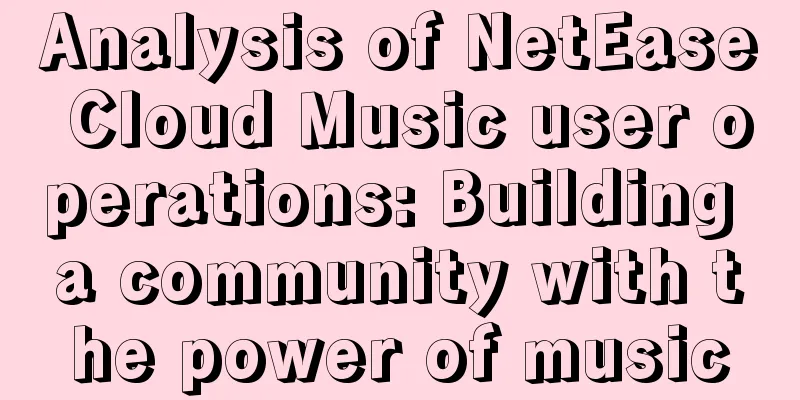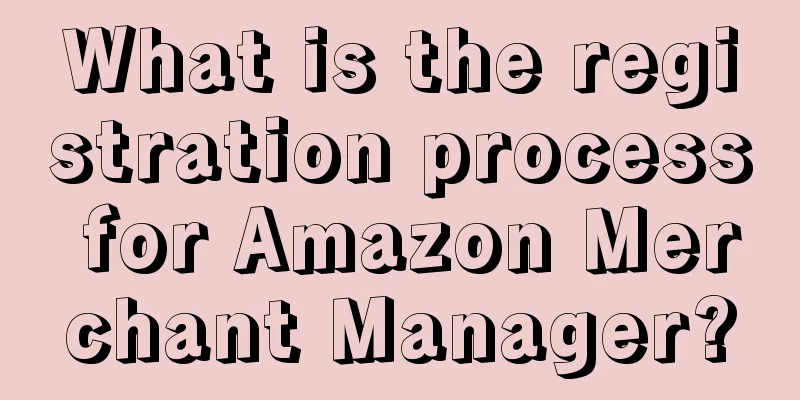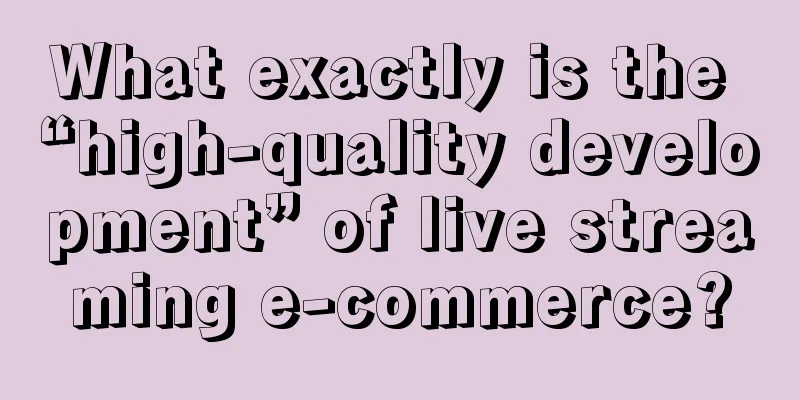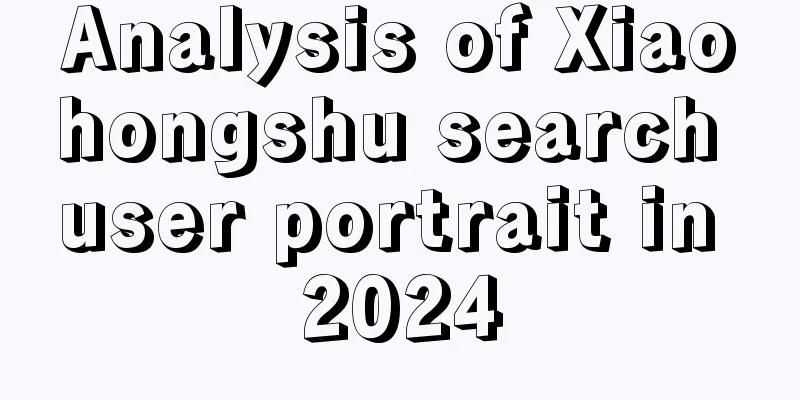Analysis of NetEase Cloud Music user operations: Building a community with the power of music

A verse from "Wu Wen" by Mao Buyi, who is also one of my favorite singers on NetEase Cloud Music. Every time I open Cloud Music, I can always feel a strong sense of humanistic care and literary atmosphere. This kind of sentiment is popular, warm and resonant. I joked with my friend before, Cloud Music has no copyright, why don't you uninstall it? His answer was: You can choose not to open it, but you can't live without it. There must be a time to open it and listen to music quietly. NetEase Cloud Music is reported to have nearly 350 million registered users, with more than 400 million playlists created by users themselves and more than 40,000 original music experts on Cloud Music. Secondly, the powerful UGC comment content has exceeded 500 million, which is already a phenomenal trend. Let's see, behind such a huge amount of user data is NetEase Cloud Music's powerful recommendation algorithm, the ultimate product experience, the resonant community voice, and the warm and emotional user operation. Their essence is inseparable from one core point, that is, the power of music. 1. Differentiated market competition, community-based vertical niche groupsJudging from the current music market environment, Cloud Music's market share, IP copyrights, and resident artists are not the largest. In comparison, the number of users on the QQ Music platform has once reached 1 billion. Backed by Tencent's diverse advertising channel traffic resources and a sufficiently rich copyright library, NetEase Cloud Music's strategic route has become increasingly differentiated in the market competition. The music community platform strategy was the embryonic strategy of NetEase Cloud Music when it was launched in 2013. In the music market environment from 2013 to 2015, the core purpose of major music platforms was to grab IP, buy copyrights, and sign artists and celebrities for exclusive channels. Of course, NetEase Cloud Music was no exception and joined this war. However, unlike other platform strategies, Cloud Music has focused on user portraits and user needs since its early stages. For the platform, users' strong demands for personalization and socialization are the best way to express their true emotions. For Cloud Music, the core needs to be addressed are two types of users (Type A and Type B). Type A users are users who have clear music demands, and music has become a rigid demand. This poses great challenges to the richness of the music library, copyright requirements, and language diversity. The solution provided by Cloud Music is to build an open content platform on the one hand, and to introduce a large amount of high-quality original content from the public through NetEase original musicians, music experts, and LOOK anchor plans to supplement its own copyright shortcomings. Secondly, Cloud Music takes advantage of the group's user big data and cloud computing to identify users' basic listening preferences and styles, and sets up data models to provide users with more accurate and matching music algorithms. In this way, the music demands of Class A users can be met in a more personalized way. Category B users are general users who do not have clear music demands and wander between various music platforms. To differentiate platforms and retain such users, NetEase Cloud Music's solution is to concentrate resources to build a UGC ecosystem. Increasing user stickiness and dependence on the platform, as well as the connection and interaction with the platform, participation, and high-quality content guidance have become the core focus of UGC marketing, thereby building long-term appeal to users. 2. RFM model defines the North Star indicator and builds a user stratification systemIn different operating scenarios, refined user operations are the key path to user retention and activity. RFM is the golden model in the e-commerce environment. It determines the importance of user stratification based on the amount of user consumption, frequency of consumption, and consumption interval within a period, and provides different differentiated subsidy strategies. For music platforms, consumption is not the core basis for division. The stratification logic given by NetEase Cloud Music is "multi-broad and deep user growth system". It is reported that the relevant patents involved in this model system have been submitted to the State Intellectual Property Office for review and belong to NetEase Cloud Music's algorithm patents.
We use a user sample publicly shared by Cloud Music's data analysis team as a reference example. 1.5% of user behavior characteristics perform high under the "Multi-Broad and Deep Growth System". They are typical music enthusiasts and also the core loyal user group of Cloud Music. In terms of "frequency", this group of people listened to music 30 days in the past 30 days, with a total music playback time of 85 hours, an average daily playback time of 2.8 hours and an average daily effective playback number of 63 times; in terms of "breadth", a total of 12 music genres and 5 languages were involved in the 30 days, including pop, soundtrack, two-dimensional, rock, etc.; in terms of "depth", more than 1,000 artists have been played in the past 30 days, of which 63% are tail artists. 3. User behavior labeling system and building a recommendation algorithm modelTag construction is the primary prerequisite for the user algorithm model. Cloud Music's solution is to match the user's behavior in the APP with the music and build the bottom layer of the model. On top of the bottom layer of the model, three types of preference attributes are divided.
With the data labeling model, the big data pool continues to accumulate data and repeatedly cleans the process, and the user's recommendation value becomes more and more similar and accurate. At this time, the platform can quickly locate the typical characteristics of a certain user and circle out people of the same type, making it easier for the platform to make accurate outreach and training plans. 4. The UGC ecosystem is becoming more mature, building a music community ecosystemThe success of Cloud Music is inseparable from UGC. As we mentioned at the beginning, Cloud Music solves the needs of two types of users. User tag construction and recommendation algorithms solve the needs of type A users, and the core of building a UGC community platform is to solve the activity and stickiness of type B users. Cloud Music has always attached great importance to the encouragement and exploration of UGC content. The current UGC ecosystem of Cloud Music has covered multiple dimensions including the creation of playlists, anchor radio stations, dynamic topic creation, comments, circles, squares, etc., truly allowing users to speak out and giving users great creativity and space. From a side point of view, it can also supplement the platform in terms of music and content supply. We might as well break down several key links in the music UGC ecosystem. Each model has differentiated product functions, and the entire chain closed loop forms vitality. The Musician Creator Program cultivates high-quality talents, the music train/music review book guides high-quality song review content, dynamic topics/circles cultivate the stickiness of circle users, and the karaoke room/square improves user activity through independent live broadcasts, gameplay, and competitions. The Musician Creator Program is one of the content providers of Cloud Music. Anyone can join and sign a contract. Cloud Music provides multiple forms of commercial realization, including on-demand revenue sharing, membership package revenue, lyrics and music trading, advertising revenue sharing, praise revenue, live broadcast rewards, etc. It is reported that Cloud Music has more than 40,000 original musicians and more than 100,000 music singles. For most users with music dreams and music conditions, it is a natural expression window. The creation of music review content, like the early NetEase forums/NetEase News, is to attract users' interactive participation through high-quality comments. For users, browsing and participating in interesting comments is often more interesting than browsing the content itself. The community atmosphere of Cloud Music is literary and emotional, and this tone also determines the content direction of the comments. Early Cloud Music reviews started with theme columns, music trains, music review books, and subsequent music columns, in the form of event special pages, using emotional atmosphere and interest incentives to guide user contact, forming a "cultural prototype" within the APP; the second stage introduced the screening of a large number of high-quality users and experts, and gradually covered the songs of top artists in the form of PGC; the third stage gradually expanded to large-scale, with a three-dimensional online and offline marketing strategy, popular Moments H5, online emotional zones, offline subway station advertisements, bus stops, and campus wall advertisements, so that the review content of Cloud Music can take root and penetrate into the minds of the target population. NetEase Cloud Music is more like a clear stream in the entire market competition. The rapid development of mobile networks has made the forms of young people's access to content more diverse and rich. The popularity of the artist economy is also rising. Take Jay Chou as an example. If Cloud Music loses Jay Chou's copyright, it will inevitably lose a large number of heavy users. But for the platform, what can be done is not to burn money to grab copyrights, but to encourage the creation of the second Jay Chou, encourage more musicians with dreams, and help users find more high-quality music. Perhaps this is the core of a platform with vitality. Author: Leon; Official Account: Leon E-commerce Notes |
>>: E-commerce is deserted, but offline is bustling: Why is Xiaohongshu's monetization fragmented?
Recommend
Video account, more like a cultivation system
Video accounts have opened up new growth space and...
Earn a million a year or can’t even make a living, the online literature industry is up and down, and will it eventually flock to short dramas?
This article takes "Post-00s online writers e...
With new regulations being released intensively, is video account e-commerce entering a runaway mode?
Video account e-commerce has recently released new...
Learn about games: design marketing mechanisms that make users addicted!
There are many people who like to play games. Game...
Is it profitable to sell products by following others on Amazon? Is there any risk in doing so?
Some products on Amazon sell well, so there will b...
What's the problem with Huaxizi?
Let's talk about brand and marketing separatel...
How to authenticate a PayPal account? Introduction to authentication methods
After registering a PayPal account, you need to au...
Is it difficult to pass the temu product selection? How does Temu select products?
Temu, as Pinduoduo's cross-border platform, ha...
Big consumption in 2022: cost reduction and efficiency improvement, industry winter, and group warming up
What will be the consumption trend in 2022? The au...
An ugly hat went viral! Is Maimen a brainwash marketing campaign?
What kind of hat caused the Internet craze? What i...
eBay UK launches performance protection for sellers
eBay UK announced that due to the severe weather c...
Is Shopee Taiwan easy to operate? What are the hot-selling products?
The current development of Shopee's cross-bord...
Changing marketing scenarios, unchanged communication models (Part 1)
The author of this article uses several simple cas...
How is the DHL fuel surcharge calculated? How to pay it?
As a world-leading logistics service provider, DHL...
What are the requirements and fees for entering Amazon Europe?
In addition to the large number of people who open...









